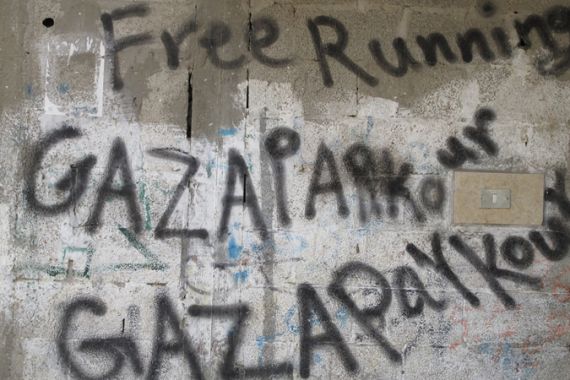
Filmmaker’s view: The free runners of Gaza
For young, often unemployed Palestinians in Gaza’s Khan Younis camp parkour has become the ultimate means of escape.
 |
| Mohammed al-Jakhbeer believes that parkour is all about overcoming obstacles [Mariam Shahin] |
In the narrow sandy alleys of the Khan Younis refugee camp Mohammed al-Jakhbeer and Abdallah Enshsi, both 22, navigate their path out of the camp and into the many corners and open spaces of the tiny strip of land which is famous for being the most densely populated in the world.
| In video |
|
|
Abdallah is a high school drop-out whose passion as a youth was acrobatics. When he discovered parkour while watching the film Jump London on television, he knew he had found his calling.
Keep reading
list of 4 itemsRussia’s Putin eyes greater support from China for Ukraine war effort
India-Iran port deal: A gateway to Central Asia or a geostrategic headache?
India’s income inequality widens, should wealth be redistributed?
Five years ago he approached Mohammed, a neighbourhood basketball star and film editing student, to join him and build a team to represent their refugee camp at local competitions and events.
The camps of Gaza are rich in hip hop, rap and other performance arts often associated with the underprivileged. The young boys and men of the camp have formed a community of performers that are foremost rich in talent, passion and spirit despite the lack of real income generating possibilities.
The people of the Khan Younis camp, like most Palestinian refugee camps, many of which have existed for 60 years, are very welcoming. A film crew of four, we were afforded a lot of hospitality during the ten days we filmed with Abdallah and Mohammed.
Coffee, tea and juice were always at hand and on one occasion, a wonderful meal of vegetables stuffed with rice was presented to us as a fait acompli. We could not refuse.
With a whisper Abdallah’s grandmother, the camp’s bone setter and natural/herbal healer, apologised that the meal did not contain meat. “Times are hard,” she said in a reminder that almost 50 per cent of the Gaza Strip’s population is unemployed.
Both Abdallah and Mohammed are unemployed as well, although they take whatever odd jobs they can – as painters, construction helpers, and even street sweepers. In one scene in the film, we show Mohammed sweeping the local vegetable market after it closed down.
A way to escape life under blockade
| In video |
|
|
Filming Mohammed and Abdallah performing parkour and free running was an unprecedented challenge for us. When George Azar and I first met the two in October 2010, we were fascinated and filmed with them for two days.
One of the scenes was in the sand dunes of one of the settlements that Israel had withdrawn from in 2005. In these sand dunes Abdallah and Mohammed had found the perfect place to train young would-be parkour performers.
At the time George found it very difficult to capture all their moves on film and he decided that if we would make a film about them, it would have to be a two camera shoot.
It took us six months to get a permit from the Israelis to return to Gaza and we returned with our editor, Eyad Hamam, who operated a second camera. In a few cases, I used a G12 to capture scenes from yet a third angle.
George mounted a GoPro camera on the TukTuk (the vehicle that Mohammed and Abdallah drove in) and thus we were able to capture their journey through Gaza from yet another angle.
One of the main logistic challenges we faced while filming inside the refugee camp, was crowd control. Everywhere we went dozens and sometimes hundreds of children followed Mohammed and Abdallah and our cameras.
There was never an incident, which interrupted our filming, but we did have to keep the kids organised in one corner or another, a very daunting task. Our veteran colleague, Raed Athamneh (the subject of the films Gaza Fixer and Gaza Fixer II), was instrumental in enabling us to film with ease inside the camps, often soliciting the help of camp residents to keep order while we worked.
Towards the end of the filming period, Abdallah and Mohammed had become part of our daily lives, and we a part of theirs. We invited them for a goodbye meal at our hotel by the sea and we saw how nervous they were to walk onto the hotel patio.
They had never been inside a hotel, not to mention a restaurant. On that last evening together we got a further insight into the private lives of these very brave and courageous free runners of Gaza. They were shy to speak to girls, since almost any contact with the opposite sex is prohibited by the customs of their society until marriage.
They were eager to learn what the world looks like “on the outside”, if people all live like them or if there is “something else” out there. They wanted the freedom to choose to travel and discover for themselves. Parkour was their way to escape the fate that Israel’s continuing blockade of air, sea and land had imposed on them.
This episode of Artscape can be seen from Friday, July 1, at the following times GMT: Friday: 1930; Saturday: 1430; Sunday: 0430; Monday: 0830. Click here for more on the series. |
